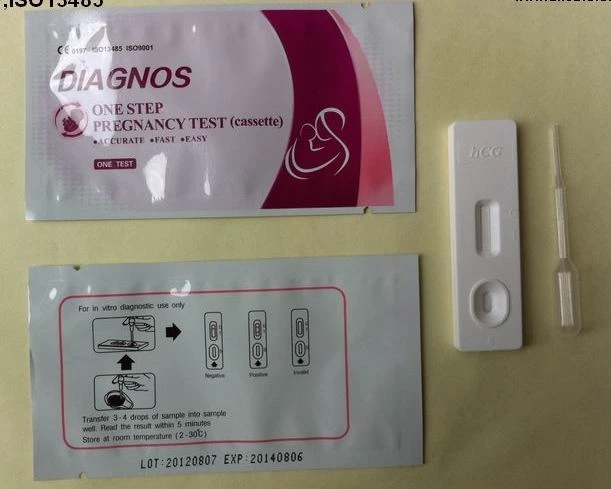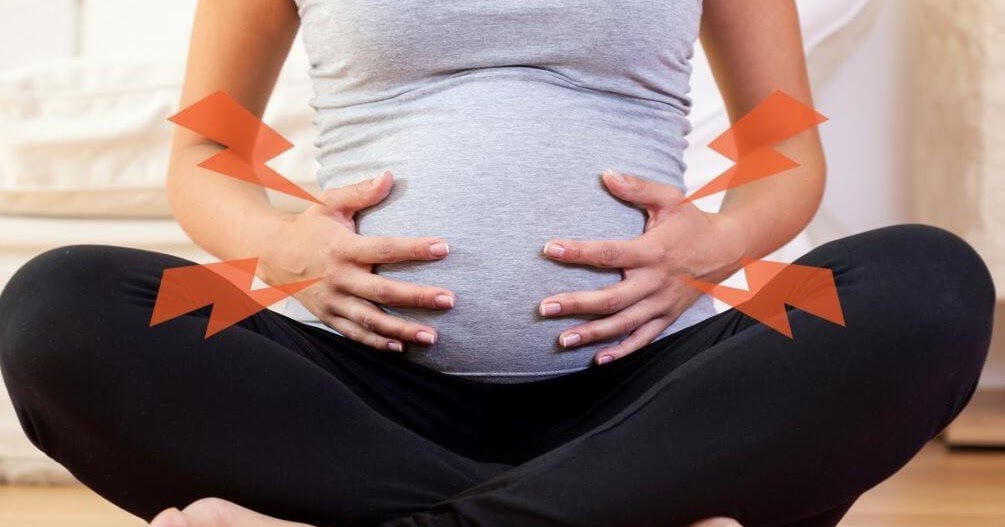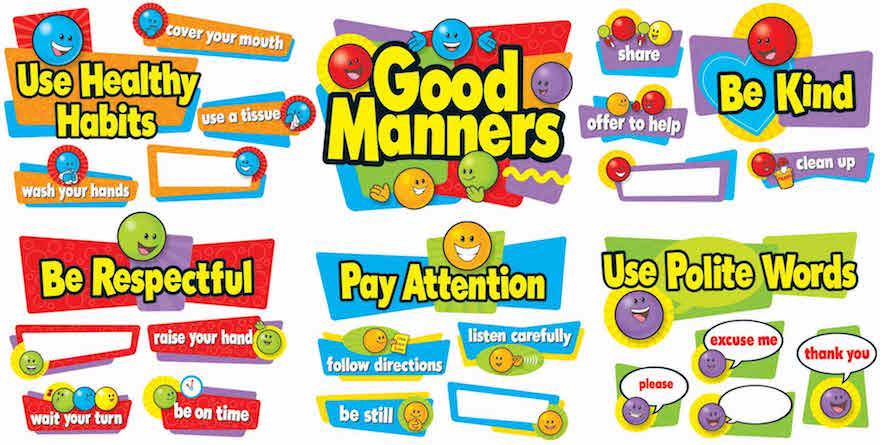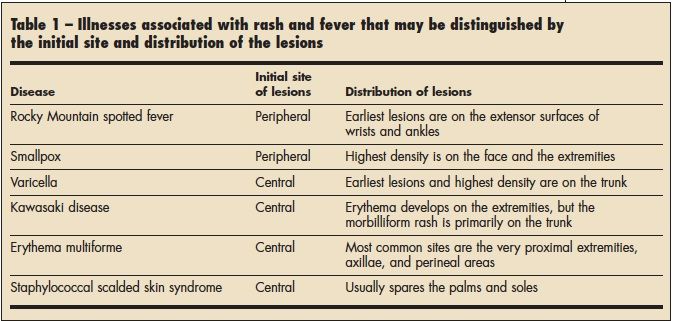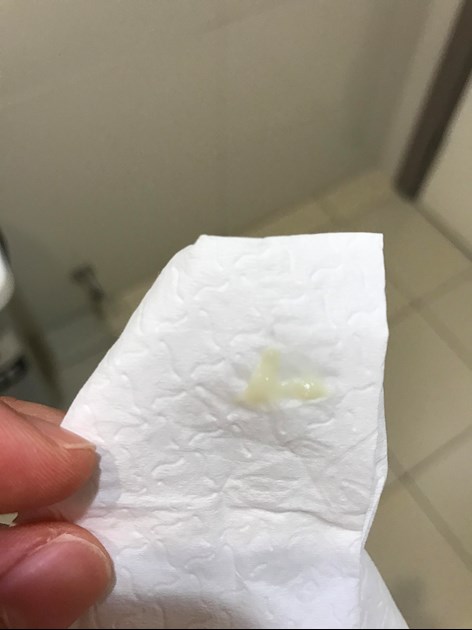How long should child stay in car seat
Car Seats: Information for Families
One of the most important jobs you have as a parent is keeping your child safe when your child is riding in a vehicle.
Each year, thousands of young children are killed or injured in car crashes. Proper use of car safety seats helps keep children safe. But, because so many different seats are on the market, many parents find this overwhelming. If you are expectant parents, consider working with a certified passenger safety technician (CPST or CPS technician), before your baby is born, to ensure a safe ride home from the hospital.
The type of seat your child needs depends on several things, including your child's age, size, and developmental needs. Here is more information from the American Academy of Pediatrics (AAP) about choosing the most appropriate car safety seat for your child.
Visit here for a listing of car seats & car seat manufacturers.
Types of car seats at a glance:
This chart is a quick guide on where to start your search. It's important to continue your research to learn about each seat you use.
Age-group | Type of Seat | General Guidelines | ||
|---|---|---|---|---|
Infants and toddlers | All infants and toddlers should ride in a rear-facing seat until they reach the highest weight or height allowed by their car safety seat manufacturer. Most convertible seats have limits that will allow children to ride rear facing for 2 years or more. | |||
Toddlers and preschoolers | Children who have outgrown the rear-facing weight or height limit for their convertible seat should use a forward-facing seat with a harness for as long as possible, up to the highest weight or height allowed by their car safety seat manufacturer. | |||
School-aged children |
| All children whose weight or height exceeds the forward-facing limit for their car safety seat should use a belt-positioning booster seat until the vehicle seat belt fits properly, typically when they have reached 4 feet 9 inches in height and are 8 to 12 years of age. All children younger than 13 years should ride in the back seat. | ||
Older children |
| When children are old enough and large enough for the vehicle seat belt to fit them correctly, they should always use lap and shoulder seat belts for the best protection. All children younger than 13 years should ride in the back seat. | ||
Car safety seats may be installed with either the vehicle's seat belt or its LATCH (lower anchors and tethers for children) system. LATCH is an attachment system for car safety seats. Lower anchors can be used instead of the seat belt to install the seat, and many parents find them easier to use in some cars. The top tether should always be used with a forward-facing seat, whether you use the seat belt or lower anchors to secure it. The seat belt and LATCH systems are equally safe, so caregivers should use one or the other, whichever works best for them, for their car safety seat, and their vehicle. In general, caregivers should only use 1 of the 2 options unless the car safety seat and vehicle manufacturers say it is OK to use 2 systems at the same time.
LATCH is an attachment system for car safety seats. Lower anchors can be used instead of the seat belt to install the seat, and many parents find them easier to use in some cars. The top tether should always be used with a forward-facing seat, whether you use the seat belt or lower anchors to secure it. The seat belt and LATCH systems are equally safe, so caregivers should use one or the other, whichever works best for them, for their car safety seat, and their vehicle. In general, caregivers should only use 1 of the 2 options unless the car safety seat and vehicle manufacturers say it is OK to use 2 systems at the same time.
Vehicles with the LATCH system have lower anchors located in the back seat, where the seat cushions meet. Tether anchors are located behind the seat, either on the panel behind the seat (in sedans) or on the back of the seat, ceiling, or floor (in most minivans, SUVs, hatchbacks, and pickup trucks). All forward-facing car safety seats have tethers or tether connectors that fasten to these anchors.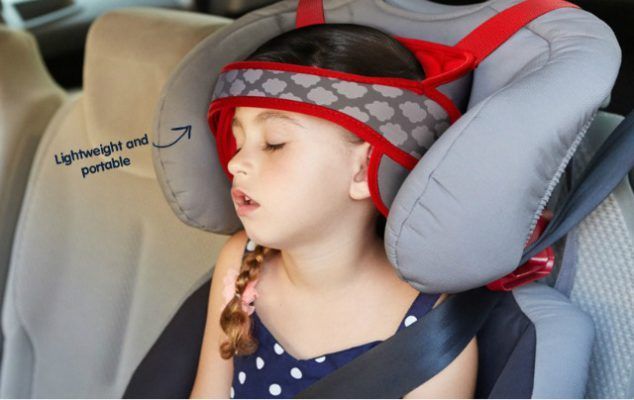 Nearly all passenger vehicles and all car safety seats made on or after September 1, 2002, are equipped to use LATCH. See vehicle owner's manual for highest weight of child allowed to use top tether.
Nearly all passenger vehicles and all car safety seats made on or after September 1, 2002, are equipped to use LATCH. See vehicle owner's manual for highest weight of child allowed to use top tether.
All lower anchors are rated for a maximum weight of 65 pounds (total weight includes car safety seat and child). Parents should check the car safety seat manufacturer's recommendations for maximum weight a child can be to use lower anchors. New car safety seats have the maximum weight printed on their label.
NOTE: Seat belts—If you install a car safety seat by using your vehicle's seat belt, you must make sure the seat belt locks to hold the seat tightly. In most newer cars, you can lock the seat belt by pulling it all the way out and then allowing it to retract to keep the seat belt tight around the car safety seat. In addition, many car safety seats have built-in lock-offs so you can lock the belt without having to lock the seat belt separately as well.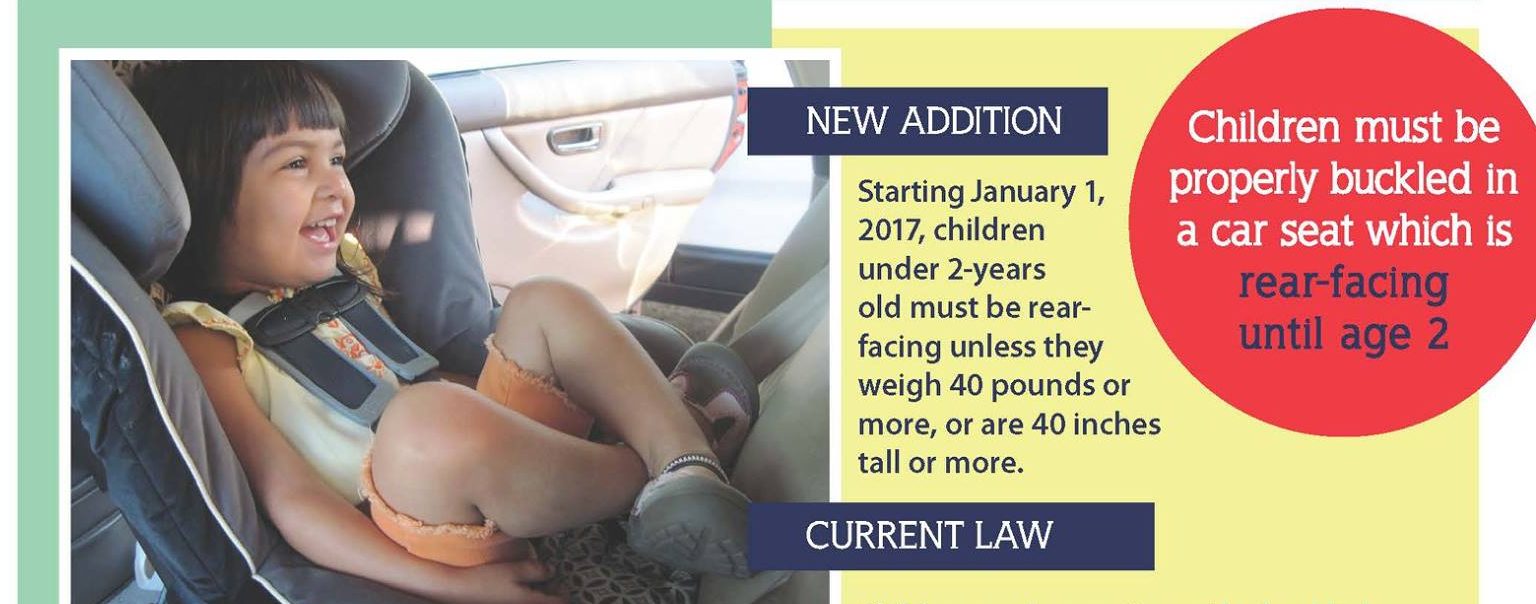 Refer to the vehicle owner's manual for details about how your seat belt locks.
Refer to the vehicle owner's manual for details about how your seat belt locks.
Middle of the back seat—The safest place to ride for all children younger than 13 years is the back seat. If possible, it may be best for the child to ride in the middle of the back seat. However, it is sometimes difficult to install a car safety seat tightly in the middle if the vehicle seat is narrow or uneven. Also, many vehicles do not have lower anchors for the middle seating position. It is safest to put the car safety seat in a position where you can install it tightly with either the lower anchor system or the seat belt; in some cases, this position may be on either side of the back seat rather than in the middle. A child passenger safety technician (CPST or CPS technician) can help you decide which place is best to install your child's car safety seat in your vehicle.
The AAP recommends that all infants ride rear facing starting with their first ride home from the hospital. All infants and toddlers should ride in a rear-facing seat as long as possible until they reach the highest weight or height allowed by their car safety seat manufacturer. Most convertible seats have limits that will allow children to ride rear facing for 2 years or more. When infants outgrow their rear-facing–only seat, a convertible seat installed rear facing is needed. All parents can benefit from getting installation help from a CPST to ensure that their child's seat is properly installed.
All infants and toddlers should ride in a rear-facing seat as long as possible until they reach the highest weight or height allowed by their car safety seat manufacturer. Most convertible seats have limits that will allow children to ride rear facing for 2 years or more. When infants outgrow their rear-facing–only seat, a convertible seat installed rear facing is needed. All parents can benefit from getting installation help from a CPST to ensure that their child's seat is properly installed.
Types of rear-facing seats
Three types of rear-facing seats are available: rear-facing–only, convertible, and all-in-one. When children reach the highest weight or length allowed by the manufacturer of their rear-facing–only seat, they should continue to ride rear facing in a convertible or all-in-one seat.
Rear-facing–only seats
Are used for infants up to 22 to 35 pounds and 26 to 35 inches, depending on the model.
Are small and have carrying handles.

Usually come with a base that can be left in the car. The seat clicks into and out of the base so you don't have to install the seat each time you use it. Parents can buy more than one base for additional vehicles.
Should be used only for a child's travel (not sleeping, feeding, or any other use outside the vehicle).
Convertible seats (used rear facing)
Can be used rear facing and, later, "converted" to forward facing for older children when they outgrow either the weight limit or the length limit for rear facing. This means the seat can be used longer by your child. Convertible seats are bulkier than infant seats, however, and they do not come with carrying handles or separate bases and are designed to stay in the car.
Many have higher limits in rear-facing weight (up to 40–50 pounds) and height than those of rear-facing– only seats, a feature that makes convertible seats ideal for bigger babies and toddlers.
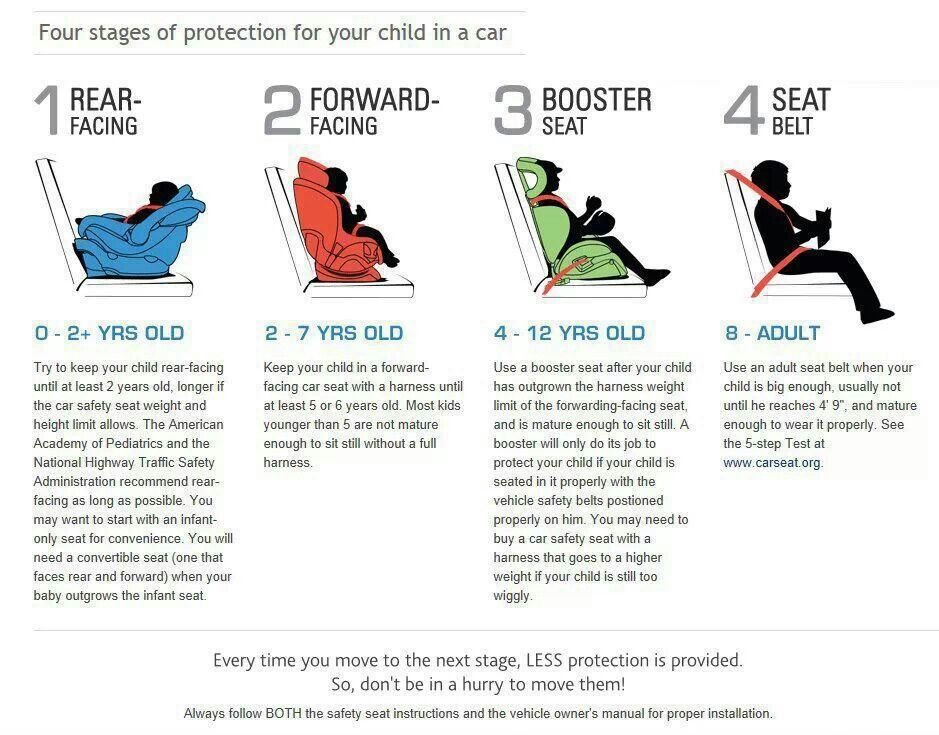
Have a 5-point harness that attaches at the shoulders, at the hips, and between the legs.
Should be used only for a child's travel (not sleeping, feeding, or any other use outside the vehicle).
All-in-one seats (used rear facing)
Can be used rear facing, forward facing, or as a belt- positioning booster. This means the seat may be used longer by your child as your child grows.
Are often bigger in size, so it is important to check that they fit in the vehicle while they are rear facing.
Do not have the convenience of a carrying handle or separate base; however, they may have higher limits in rear-facing weight (up to 40–50 pounds) and height than those of rear-facing–only seats, a feature that makes all-in-one seats ideal for bigger babies and toddlers.
Installation tips for rear-facing seats
Always read the vehicle owner's manual and the car safety seat manual before installing the seat.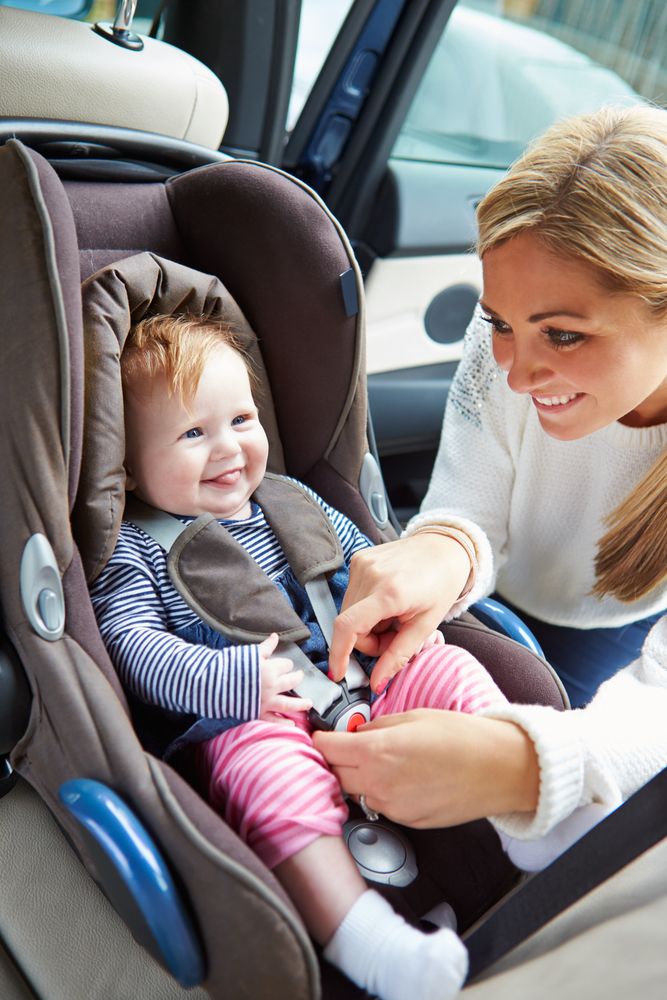
When using a rear-facing seat, keep the following tips in mind:
Place the harnesses in your rear-facing seat in slots that are at or below your child's shoulders.
Ensure that the harness is snug (you cannot pinch any slack between your fingers when testing the harness straps over the child's shoulders) and that the chest clip is placed at the center of the chest, even with your child's armpits.
Make sure the car safety seat is installed tightly in the vehicle with either lower anchors or a locked seat belt. Many car safety seats have an integrated lock-off system to keep the seat belt locked. If your seat has one, follow the manufacturer's recommendations on how to use it. If you can move the seat at the belt path more than an inch side to side or front to back, it's not tight enough.
Never place a rear-facing seat in the front seat of a vehicle that has an active front passenger airbag. If the airbag inflates, it will hit the back of the car safety seat, right against your child's head, and could cause serious injury or death.

If you are using a convertible or all-in-one seat in the rear-facing position, make sure the seat belt or lower anchor webbing is routed through the correct belt path. Check the instructions that came with the car safety seat to be sure.
Make sure the seat is at the correct angle so your child's head does not flop forward. Check the instructions to find out the correct angle for your seat and how to adjust the angle if needed. All rear-facing seats have built-in recline indicators.
Check the car safety seat instructions and vehicle owner's manual about whether the car safety seat may contact the back of the vehicle seat in front of it.
Still having trouble? Check with a certified CPST in your area who can help.
Common questions
What if my child's feet touch the back of the vehicle seat?
What do I do if my child slouches down or to the side in the car seat?
You can try placing a tightly rolled receiving blanket on both sides of your child.
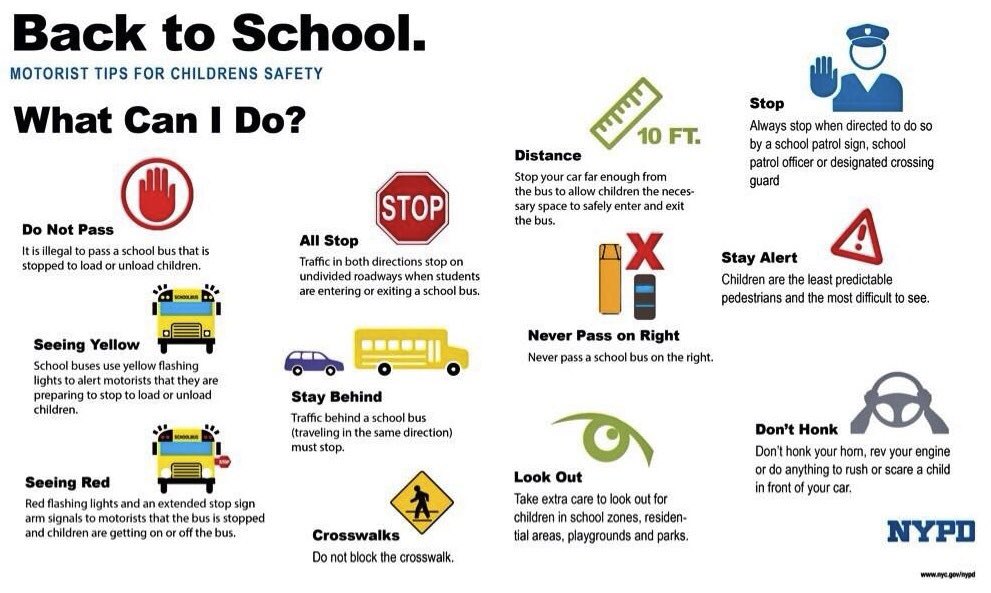 Many manufacturers allow the use of a tightly rolled small diaper or cloth between the crotch strap and your child, if necessary, to prevent slouching. Do not place padding under or behind your child or use any sort of car safety seat insert unless it came with the seat or was made by the manufacturer for use with that specific seat.
Many manufacturers allow the use of a tightly rolled small diaper or cloth between the crotch strap and your child, if necessary, to prevent slouching. Do not place padding under or behind your child or use any sort of car safety seat insert unless it came with the seat or was made by the manufacturer for use with that specific seat.
Why should I dress my child in thinner layers of clothing before strapping them into a car safety seat?
Bulky clothing, including winter coats and snowsuits, can compress in a crash and leave the straps too loose to restrain your child, leading to increased risk of injury. Ideally, dress your baby in thinner layers and wrap a coat or blanket around your baby over the buckled harness straps if needed. See Winter Car Seat Safety Tips from the AAP.
Do preemies need a special car seat?
A car safety seat should be approved for a baby's weight. Very small babies who can sit safely in a semi-reclined position usually fit better in rear-facing–only seats.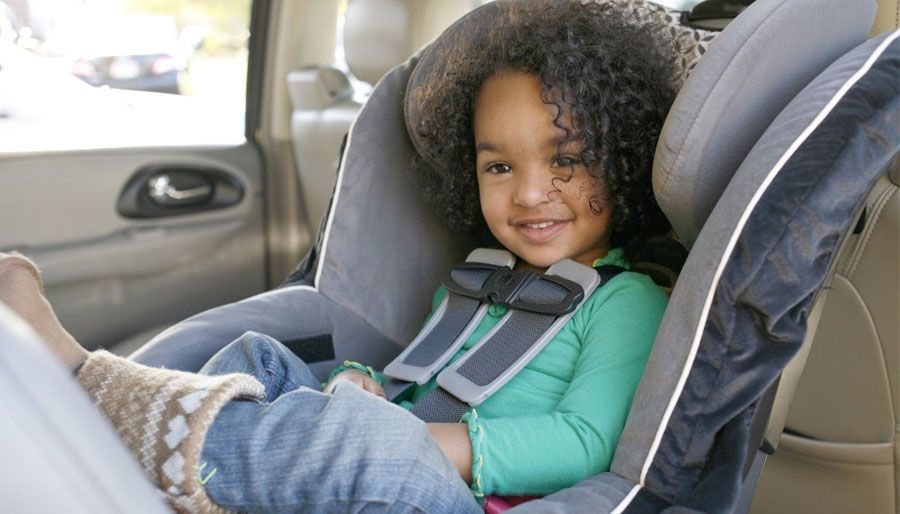 Babies born preterm should be screened while still in the hospital to make sure they can sit safely in a semi-reclined position. Babies who need to lie flat during travel may be able to ride in a car bed that meets Federal Motor Vehicle Safety Standard 213. They should be screened again while in the hospital to make sure they can lie safely in the car bed.
Babies born preterm should be screened while still in the hospital to make sure they can sit safely in a semi-reclined position. Babies who need to lie flat during travel may be able to ride in a car bed that meets Federal Motor Vehicle Safety Standard 213. They should be screened again while in the hospital to make sure they can lie safely in the car bed.
Always read the vehicle owner's manual and the car safety seat manual before installing the seat.
Any child who has outgrown the rear-facing weight or height limit for her convertible seat should use a forward- facing seat with a harness for as long as possible, up to the highest weight or height allowed by her car safety seat manufacturer. It is best for children to ride in a seat with a harness as long as possible, at least to 4 years of age. If your child outgrows a seat before reaching 4 years of age, consider using a seat with a harness approved for higher weights and heights.
Types of Forward-Facing Car Seat Restraints
Four types of car safety restraints can be used forward facing:
Convertible seats: Seats can "convert" from rear facing to forward facing.
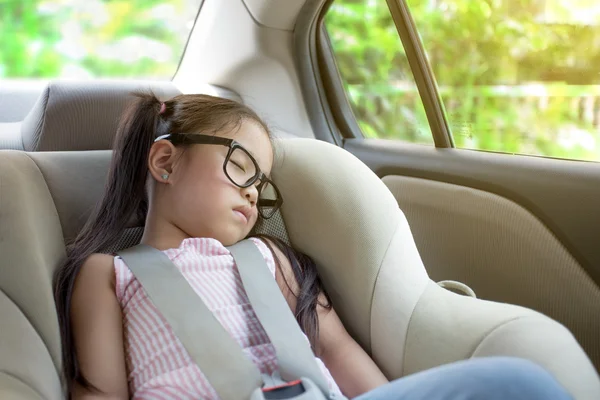 These include all-in-one seats.
These include all-in-one seats.Combination seats with harness: Seats can be used forward facing with a harness for children who weigh up to 40 to 65 pounds (depending on the model) or without the harness as a booster (up to 100–120 pounds, depending on the model).
Integrated seats: Some vehicles come with built-in forward-facing seats. Weight and height limits vary. Do not use a built-in seat until your child has reached the highest weight or height allowed for your rear-facing convertible car safety seat. Read your vehicle owner's manual for details about how to use these seats.
Travel vests: Vests can be worn by children 22 to 168 pounds and can be an option to traditional forward- facing seats. They are useful for when a vehicle has lap-only seat belts in the rear, for children with certain special needs, or for children whose weight has exceeded that allowed by car safety seats.
 These vests usually require use of a top tether.
These vests usually require use of a top tether.
Installation tips for forward-facing seats
Always read the vehicle owner's manual and the car safety seat manual before installing the seat.
It is important that the car safety seat is installed tightly in the vehicle and that the harness fits your child snugly.
To switch a convertible or all-in-one seat from rear-facing to forward-facing:
Move the harness shoulder straps to the slots or position that is at or just above your child's shoulders. Check the instructions that came with the seat to be sure you are positioning the shoulder straps correctly.
You may have to adjust the recline angle of the seat so that it sits more upright in your vehicle. Check the instructions to be sure.
If using a seat belt, make sure it runs through the forward-facing belt path (be sure to follow car safety seat instructions) and that the seat belt is locked and tightened.
 Many car safety seats have an integrated lock-off to keep the seat belt locked. If your seat has one, follow the manufacturer's recommendations on how to use it.
Many car safety seats have an integrated lock-off to keep the seat belt locked. If your seat has one, follow the manufacturer's recommendations on how to use it.If using the lower anchors, make sure that the weight of your child plus the weight of the seat does not exceed 65 pounds. Most seats now state in the manual and on the stickers on the side the maximum child weight to use the anchors. If the child weighs too much, caregivers must use the seat belt to install.
Always use the tether when you can. A tether is a strap that is attached to the top part of a car safety seat and holds the seat tightly by connecting to an anchor point in your vehicle (often on the seat back or rear shelf; see your vehicle owner's manual to find where tether anchors are in your vehicle). Tethers give important extra protection by keeping the car safety seat and your child's head from moving too far forward in a crash or sudden stop. All new cars, minivans, and light trucks are required to have tether anchors as of September 2000.
 Forward-facing seats come with tether straps. A tether should always be used as long as your child has not reached the top weight limit for the tether anchor. Check the car safety seat instructions and vehicle owner's manual for information about the top weight limit and locations of tether anchors.
Forward-facing seats come with tether straps. A tether should always be used as long as your child has not reached the top weight limit for the tether anchor. Check the car safety seat instructions and vehicle owner's manual for information about the top weight limit and locations of tether anchors. Watch the Video: How to Install a Forward-Facing Car Seat
Common question
What if I drive more children than those who can be buckled safely in the back seat?
It's best to avoid this, especially if your vehicle has airbags in the front seat. All children younger than 13 years should ride in the back seat. If absolutely necessary, a child in a forward-facing seat with a harness may be the best choice to ride in front. Just be sure the vehicle seat is moved as far back away from the dashboard (and airbag) as possible.
Booster seats are for older children who have outgrown their forward-facing seats. All children whose weight or height exceeds the forward-facing limit for their car safety seat should use a belt-positioning booster seat until the vehicle seat belt fits properly, typically when they have reached 4 feet 9 inches in height and are 8 to 12 years of age. Most children will not fit in most vehicle seat belts without a booster until 10 to 12 years of age. All children younger than 13 years should ride in the back seat. Instructions that come with your car safety seat will tell you the height and weight limits for the seat. As a general guideline, a child has outgrown a forward-facing seat when any of the following situations is true:
All children whose weight or height exceeds the forward-facing limit for their car safety seat should use a belt-positioning booster seat until the vehicle seat belt fits properly, typically when they have reached 4 feet 9 inches in height and are 8 to 12 years of age. Most children will not fit in most vehicle seat belts without a booster until 10 to 12 years of age. All children younger than 13 years should ride in the back seat. Instructions that come with your car safety seat will tell you the height and weight limits for the seat. As a general guideline, a child has outgrown a forward-facing seat when any of the following situations is true:
They reach the top weight or height allowed for his seat with a harness. (These limits are listed on the seat and in the instruction manual.)
Their shoulders are above the top harness slots.
The tops of their ears have reached the top of the seat.
Types of booster seats
High-back and backless are 2 standard types of booster seats. They do not come with a harness but are used with lap and shoulder seat belts in your vehicle, the same way an adult rides. They are designed to raise a child up so that lap and shoulder seat belts fit properly over the strongest parts of the child's body.
They do not come with a harness but are used with lap and shoulder seat belts in your vehicle, the same way an adult rides. They are designed to raise a child up so that lap and shoulder seat belts fit properly over the strongest parts of the child's body.
Most booster seats are not secured to the vehicle seat with the seat belt or lower anchors and tether but simply rest on the vehicle seat and are held in place once the seat belt is fastened over a child. However, some models of booster seats can be secured to the vehicle seat and kept in place by using the lower anchors and tether along with lap and shoulder belts. (Currently, only a few vehicle manufacturers offer integrated booster seats.)
Installation tips for booster seats
When using a booster seat, always read the vehicle owner's manual and the car safety seat manual before installing the seat. Booster seats often have a plastic clip or guide to correctly position vehicle lap and shoulder belts. See the booster seat instruction manual for directions on how to use the clip or guide. Booster seats must be used with lap and shoulder belts. When using a booster seat, make sure:
Booster seats must be used with lap and shoulder belts. When using a booster seat, make sure:
The lap belt lies low and snug across your child's upper thighs.
The shoulder belt crosses the middle of your child's chest and shoulder and is off the neck.
Watch the video: How to Use a Booster Seat
If your booster seat has lower anchors or tether attachments, check its manual for installation instructions.
Common questions about booster seats
What if my car has only lap belts in the back seat?
Lap belts work fine with rear-facing–only, convertible, and forward-facing seats that h av e a harness but can never be used with a booster seat. If your car has only lap belts, use a forward-facing seat that has a harness and higher weight limits. You could also
Check to see if shoulder belts can be installed in your vehicle.
Use a travel vest (check the manufacturer's instructions about the use of lap belts only and about the use of lap and shoulder belts).
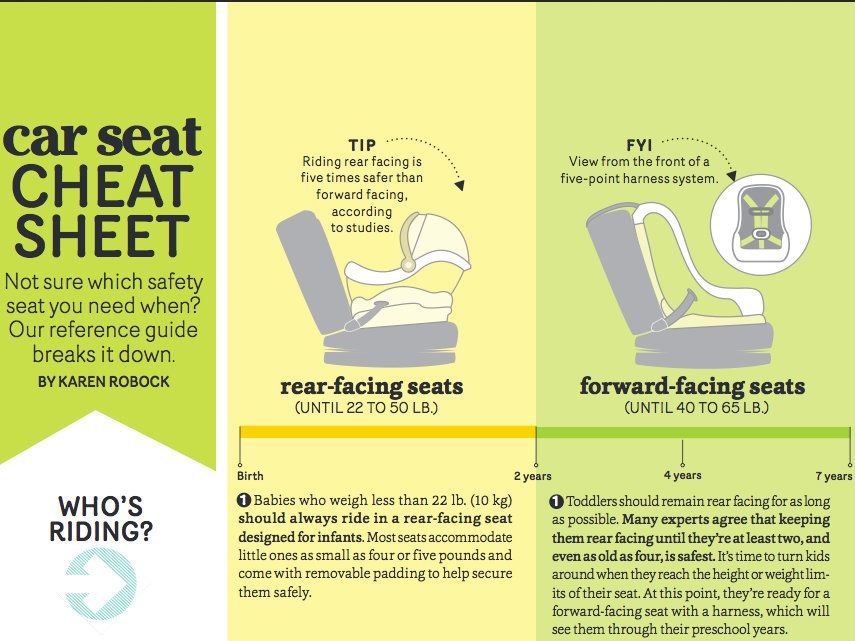
Consider buying another car with lap and shoulder belts in the back seat.
What is the difference between high-back boosters and backless boosters?
Both types of boosters are designed to raise your child so seat belts fit properly, and both will reduce your child's risk of injury in a crash. High-back boosters should be used in vehicles without headrests or with low seat backs. Many seats that look like high-back boosters are actually combination seats. They come with harnesses that can be used for smaller children and, later, removed for older children. Backless boosters are usually less expensive and are easier to move from one vehicle to another. Backless boosters can be used safely in vehicles with headrests and high seat backs.
Seat belts are made for adults. Children should stay in a booster seat until adult seat belts fit correctly, typically when children reach about 4 feet 9 inches in height and are 8 to 12 years of age.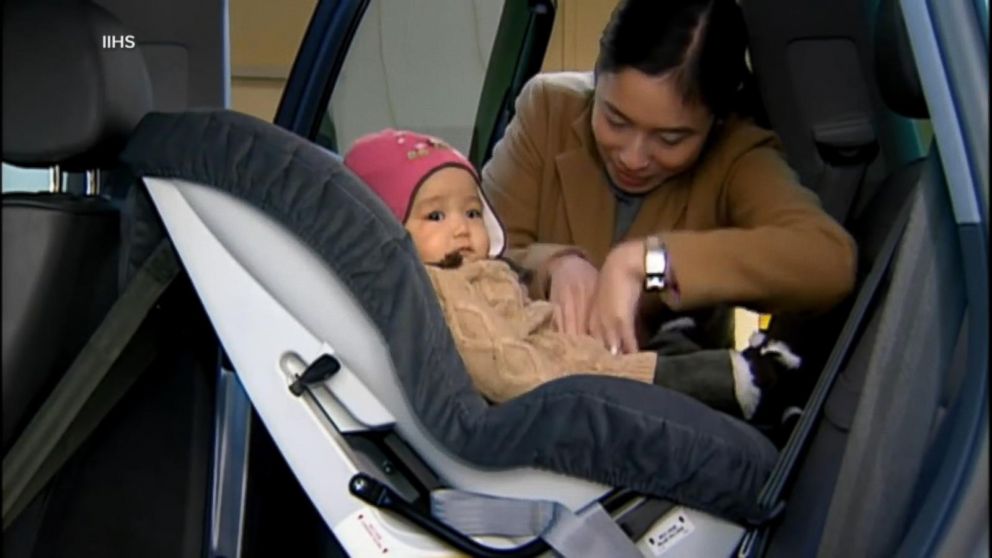 Most children will not fit in a seat belt alone until 10 to 12 years of age. When children are old enough and large enough to use the vehicle seat belt alone, they should always use lap and shoulder seat belts for the best protection. All children younger than 13 years should ride in the back seat.
Most children will not fit in a seat belt alone until 10 to 12 years of age. When children are old enough and large enough to use the vehicle seat belt alone, they should always use lap and shoulder seat belts for the best protection. All children younger than 13 years should ride in the back seat.
Using a seat belt:
An adult seat belt fits correctly when:
The shoulder belt lies across the middle of the chest and shoulder, not the neck or throat.
The lap belt is low and snug across the upper thighs, not the belly.
Your child is tall enough to sit against the vehicle seat back with her knees bent over the edge of the seat without slouching and can comfortably stay in this position throughout the trip.
Other points to keep in mind when using seat belts include:
Make sure your child does not tuck the shoulder belt under her arm or behind her back. This leaves the upper body unprotected and adds extra slack to the seat belt system, putting your child at risk of severe injury in a crash or with sudden braking.

Never allow anyone to "share" seat belts. All passengers must have their own car safety seats or seat belts.
Common question
I've seen products that say they can help make the seat belt fit better. Should we get one of these?
No, these products are unapproved and should not be used. They may actually interfere with proper seat belt fit by causing the lap belt to ride too high on the stomach or making the shoulder belt too loose. They can even damage the seat belt. This rule applies to car safety seats too; do not use extra products unless they came with the seat or are specifically approved by the seat manufacturer. These products are not covered by any federal safety standards, and the AAP does not recommend they be used. As long as children are riding in the correct restraint for their size, they should not need to use additional devices.
When shopping for a car seat, keep the following tips in mind:
No one seat is the "best" or "safest.
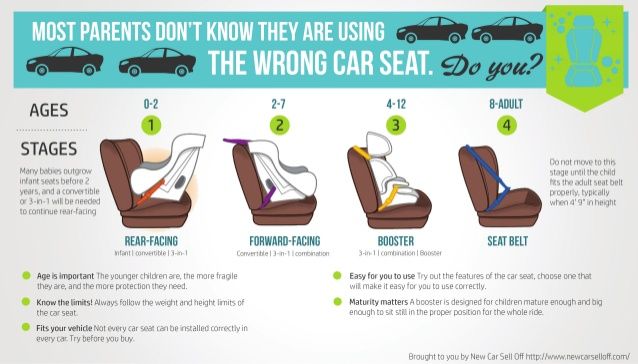 " The best seat is the one that fits your child's size, is correctly installed, fits well in your vehicle, and is used properly every time you drive.
" The best seat is the one that fits your child's size, is correctly installed, fits well in your vehicle, and is used properly every time you drive.Don't decide by price alone. A higher price does not mean the seat is safer or easier to use.
Avoid used seats if you don't know the seat's history.
Watch the Video: What to Look For When Purchasing a Car Seat
Never use a car seat that:
Is too old. Look on the label for the date the seat was made. Check with the manufacturer to find out how long it recommends using the seat.
Has any visible cracks on it.
Does not have a label with the date of manufacture and model number. Without these, you cannot check to see if the seat has been recalled.
Does not come with instructions.
 You need them to know how to use the seat. Instructions can be found on manufacturer websites or by contacting the manufacturer.
You need them to know how to use the seat. Instructions can be found on manufacturer websites or by contacting the manufacturer.Is missing parts. Used car safety seats often come without important parts. Check with the manufacturer to make sure you can get the right parts.
Was recalled. You can find out by calling the manufacturer or contacting the National Highway Traffic Safety Administration (NHTSA) Vehicle Safety Hotline at 888/327-4236. You can also visit the NHTSA Website.
Do not use seats that have been in a moderate or severe crash. Seats that were in a minor crash may still be safe to use, but some car safety seat manufacturers recommend replacing the seat after any crash, even a minor one. The NHTSA considers a crash minor if all the following situations are true:
The vehicle could be driven away from the crash.
The vehicle door closest to the car safety seat was not damaged.

No one in the vehicle was injured.
The airbags did not go off.
You can't see any damage to the car safety seat.
If you have specific questions about the car seat, contact the manufacturer.
Front airbags are installed in all new cars. When used with seat belts, airbags work well to protect teenagers and adults; however, airbags can be very dangerous to children, particularly to those riding in rear-facing seats and to preschoolers and young school-aged children who are not properly restrained. If your vehicle has a front passenger airbag, infants in rear-facing seats must ride in the back seat. Even in a relatively low-speed crash, the airbag can inflate, strike the car safety seat, and cause serious brain injury and death.
Vehicles with no back seat or a back seat that is not made for passengers are not the best choice for traveling with small children; however, the airbag can be turned off in some of these vehicles if the front seat is needed for a child passenger. See your vehicle owner's manual for more information.
See your vehicle owner's manual for more information.
Side airbags are available in most new cars. Side airbags improve safety for adults in side-impact crashes. Read your vehicle owner's manual for more information about the airbags in your vehicle. Read your car safety seat instructions and the vehicle owner's manual for guidance on placing the seat next to a side airbag.
About carpooling
If your child is being driven by someone else, make sure:
The car safety seat your child will be using fits properly in the vehicle used for transport.
The car safety seat being used is appropriate for the age and size of your child.
The person in charge of transporting your child knows how to install and use the car safety seat correctly.
Child care programs and schools should have written guidelines for transporting children, including
All drivers must have a valid driver's license.
 In some states, school bus drivers need to have a special type of license.
In some states, school bus drivers need to have a special type of license.Staff to child ratios for transport should meet or exceed those required for the classroom.
Every child should be supervised during transport, either by school staff or a parent volunteer, so the driver can focus on driving.
School staff, teachers, and drivers should know what to do in an emergency, know how to properly use car safety seats and seat belts, and be aware of other safety requirements.
About car safety seats on airplanes
The Federal Aviation Administration (FAA) and the AAP recommend that children less than 40 pounds be securely fastened in certified child restraints when flying. This will help keep them safe during takeoff and landing or in case of turbulence. Most rear-facing, convertible, and forward-facing seats can be used on airplanes , but booster seats and travel vests cannot.
Read your seat's instruction manual and look for a label on the car safety seat that says, "This restraint is certified for use in motor vehicles and aircraft. " You can also consider using a restraint made only for use on airplanes and approved by the FAA. Larger children may use the airplane seat belt or continue to use their car safety seat on the airplane as long as it is labeled for use on aircraft and the child has not exceeded the seat's weight or height limit. Remember that your child will need an appropriate car safety seat to use at your destination. For more information, visit the
FAA Website or the
CARES (Airplane Safety Harness for Children) Website.
" You can also consider using a restraint made only for use on airplanes and approved by the FAA. Larger children may use the airplane seat belt or continue to use their car safety seat on the airplane as long as it is labeled for use on aircraft and the child has not exceeded the seat's weight or height limit. Remember that your child will need an appropriate car safety seat to use at your destination. For more information, visit the
FAA Website or the
CARES (Airplane Safety Harness for Children) Website.
If you need installation help
If you have questions or need help with installing your car safety seat, find a certified child passenger safety technician (CPST or CPS technician). Lists of certified CPSTs and child seat–fitting stations are available on the following websites:
National Child Passenger Safety Certification (Click on "Find a Tech" or call 877-366-8154.) – Includes list of CPSTs fluent in Spanish and other languages or with extra training in transportation of children with special needs.

NHTSA Parents & Caregivers
Important reminders
Be a good role model. Make sure you always wear your seat belt. This will help your child form a lifelong habit of buckling up.
Make sure that everyone who transports your child uses the correct car safety seat or seat belt on every trip, every time. Being consistent with car safety seat use is good parenting, reduces fussing and complaints, and is safest for your child.
Never leave your child alone in or around cars, and lock your vehicle when it is not in use. Any of the following situations can happen when a child is left alone in or around a vehicle. A child can
Die of heatstroke because temperatures can reach deadly levels in minutes.
Be strangled by power windows, retracting seat belts, sunroofs, or accessories.
Knock the vehicle into gear, setting it into motion.

Be backed over when the vehicle backs up.
Become trapped in the trunk of the vehicle.
Always read and follow the manufacturer's instructions for your car safety seat. If you do not have those, write or call the company's customer service department. Staff will ask you for the model number, name of seat, and date of manufacture. The manufacturer's address and phone number are on a label on the seat. Also, be sure to follow the instructions in your vehicle owner's manual about using car safety seats. Some manufacturers' instructions may be available on their websites.
Remember to fill out and mail in the registration card that comes with the car safety seat. You can also register your seat on the manufacturer's website. It will be important in case the seat is recalled.
Follow manufacturer directions for cleaning car seats. Cleaning but not disinfecting is usually permitted. That's because disinfectant products may decrease the protection provided by the seat and harness.
That's because disinfectant products may decrease the protection provided by the seat and harness.
More information
-
Ask the Pediatrician: Is it safe for my baby to travel in a car seat a few hours at a time?
- Car Seats: Product Listing
- Car Seat Checkup
- Car Seats and Obese Children: Suggestions for Parents
- Prevent Child Deaths in Hot Cars
- Travel Safety During COVID-1 9
Although the AAP is not a testing or standard-setting organization, this article sets forth the AAP recommendations based on the peer-reviewed literature available at the time of its publication and sets forth some of the factors that parents should consider before selecting and using a car seat.
Figure 1 adapted from US Department of Transportation, National Highway Traffic Safety Administration (NHTSA). LATCH Makes Child Safety Seat Installation as Easy as 1-2-3. Washington, DC: NHTSA; 2011. DOT HS publication 809 489.
Washington, DC: NHTSA; 2011. DOT HS publication 809 489.
Figure 4 from Bull MJ, Engle WA; American Academy of Pediatrics Committee on Injury, Violence, and Poison Prevention and Committee on Fetus and Newborn. Safe transportation of preterm and low birth weight infants at hospital discharge. Pediatrics. 2009;123(5):1424–1429.
The information contained on this Web site should not be used as a substitute for the medical care and advice of your pediatrician. There may be variations in treatment that your pediatrician may recommend based on individual facts and circumstances.
2 Hour Rule | Baby Safe
DO YOU KNOW WHAT THE 2 HOUR RULE IS?In a recent survey, 58% of parents had not heard of the 2 Hour Rule.
With the serious health implications of not following the 2 Hour Rule, it seems that there is a dangerous lack of information available to parents.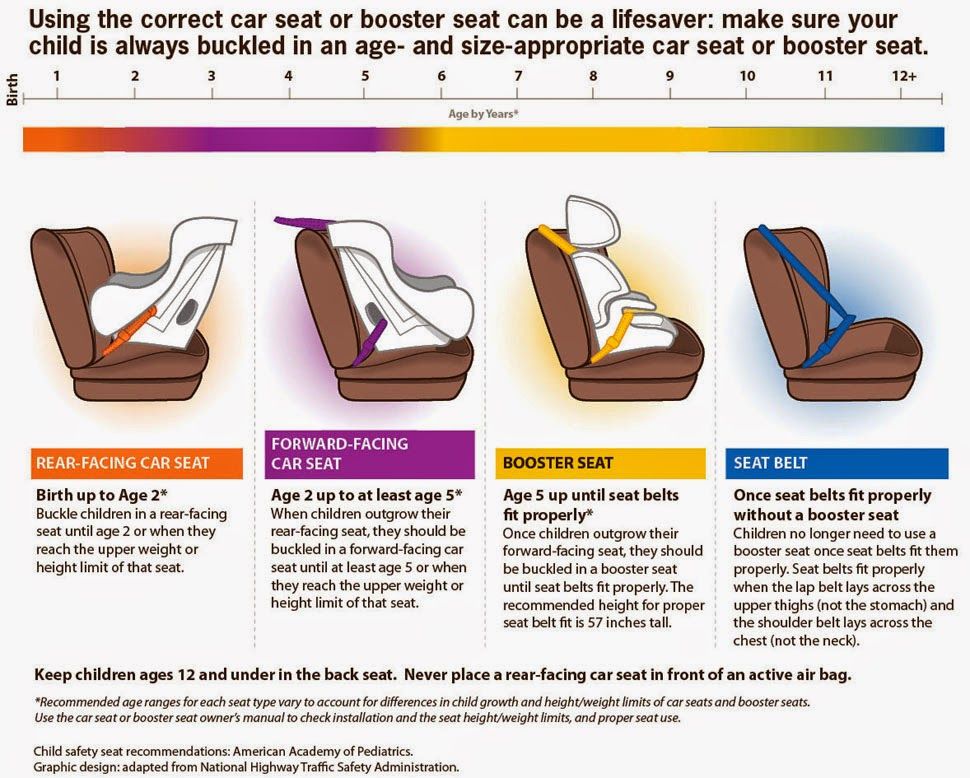
SO WHAT IS THE 2 HOUR RULE?
Many car seat manufacturers recommend that a baby should not be in a car seat for longer than 2 hours, within a 24 hour time period.
This is because when a baby is in a semi-upright position for a prolonged period of time it can result in:
1. A strain on the baby’s still-developing spine.
2. Restricted air-flow to the baby’s lungs. The chance of this can increase if a baby falls asleep with their head flopped forward.
WHY SHOULD YOU FOLLOW THE 2 HOUR RULE?
Due to the lack of information available for parents about the safety of babies in car seats, Michelle Clark, Neonatal Unit Sister at DRI, decided to find out more about the subject to help raise parents’ awareness of the risk of car seat cot death.
Outlined below are some of Michelle’s findings.
Breathing Problems
Young babies may experience respiratory (breathing) problems if placed in a sitting position or car seat.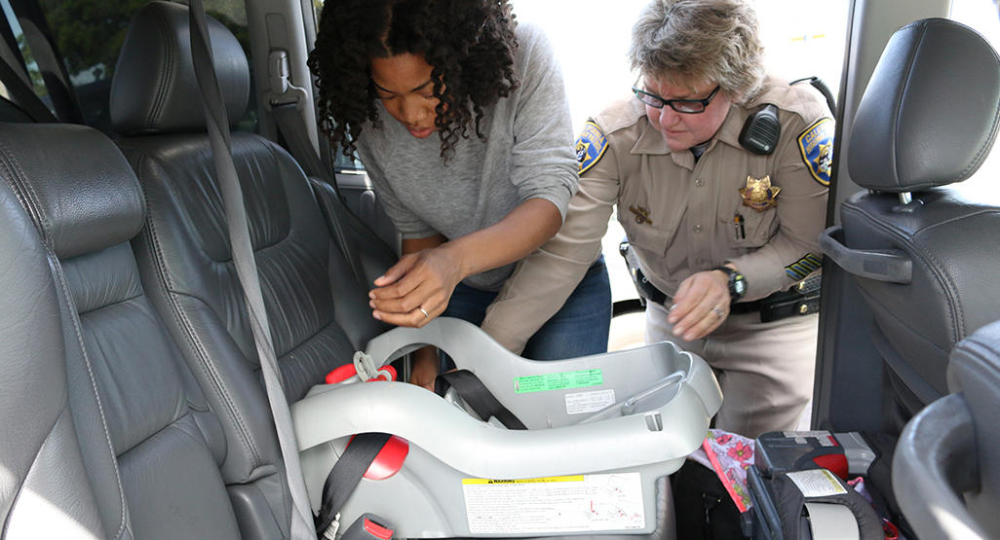 A newborn baby’s reflex to keep its head held up is not fully developed, meaning the head flops down and restricts the airway.
A newborn baby’s reflex to keep its head held up is not fully developed, meaning the head flops down and restricts the airway.
It is always best to keep a young baby on their back wherever possible.
Car seats should only be used to transport babies in cars, and other sitting baby equipment should only be used once the baby is strong enough to support their own head.
More about Michelle Clark…
Michelle’s interest was prompted by the lack of information available to parents about babies in car seats. Health professionals also knew very little of the research conducted and subsequently the potential dangers of prolonged and bad positioning of vulnerable babies in car seats.
Michelle has spent two years researching this subject, studying the findings from various sources, including New Zealand researchers, and the Foundation for Sudden Infant Death (FSID).
The importance of Michelle’s work…
“Michelle’s work is being published nationally, demonstrating the importance attached to her work. I encourage every parent who uses a car seat for their baby to use this information to keep their baby safe. It is important to inform parents, other family members, and the general public when new knowledge is available. Everyone who cares for a baby should be fully aware of the potential risk of car seat cot death and how to minimise it.”
I encourage every parent who uses a car seat for their baby to use this information to keep their baby safe. It is important to inform parents, other family members, and the general public when new knowledge is available. Everyone who cares for a baby should be fully aware of the potential risk of car seat cot death and how to minimise it.”
Hilary Bond, Director of Nursing & Quality
CAR SEATS SHOULD ONLY BE USEDTO TRANSPORT BABIES IN CARS
Car seats are designed to keep babies safe while travelling, not as a main sleeping place.
The research recommends that frequent breaks are taken on long journeys to get the baby out of the seat, even if this involves waking the baby up. The same applies when bringing the baby into the home if they have fallen asleep in the car seat. The baby’s warm outdoor clothing should be taken off, even if this involves waking the baby.
If the baby is due a sleep, they should be taken out of the car seat and put into a cot or crib; the safest place for a baby to sleep is on a firm, flat mattress – a car seat does not meet this requirement.
Worryingly, it has been found that some babies were spending hour after hour in car seats, ie during the journey, transferring the car seat in a travel system pram, and once home allowing the baby to continue sleeping in the car seat rather than waking the baby up and placing in them in a cot or crib.
All the advice suggests that babies should not spend longer than possible in a car seat, especially whilst sleeping.
USEFUL TIPS TO HELP AVOID CAR SEAT COT DEATHBY MICHELLE CLARK
l
The safest place for a baby to sleep is in a cot or crib on their back and in the same room as a parent or carer.
l
Car seats should only be used to transport babies in cars.
l
Make sure the car seat you buy is age appropriate and correctly fitted, to ensure your baby remains secure.
l
Where possible, babies travelling in a car seat should be observable by a responsible adult.
l
Babies find it difficult to regulate their temperature and quickly overheat. When in the car, remove any headgear the baby is wearing as they lose excess heat through their head.
When in the car, remove any headgear the baby is wearing as they lose excess heat through their head.
l
Stop your baby from scrunching up and over, keep an eye on their neckline.
l
You should never use a car seat in the house for your baby to sleep in.
l
Make sure grandparents and carers know how to fit the car seat and watch them practice.
l
If you are a lone driver driving a significant distance use services to check on your baby.
l
Be wary of thick snowsuits. It may be cold outside, but cars can heat up quickly. Natural materials will help the baby’s body with heat rather than nylon, polyester, and other man-made fabrics.
"How long can an infant be in a car seat?"
Health
- Photo
- Getty Images
In our “Ask the Expert” column, reader Elizaveta asks:
“We went to another city with our child for the holidays. Drive approximately 10 hours. Daughter is 3 months old. He tolerates short trips well, falls asleep immediately. How long can you keep a child in a car seat without a break? Can you sleep in it?
Drive approximately 10 hours. Daughter is 3 months old. He tolerates short trips well, falls asleep immediately. How long can you keep a child in a car seat without a break? Can you sleep in it?
Founder and director of the BabySleep Center for Children's Sleep and Development, author of a unique methodology for teaching self-sleep, mother of three children
Personal website
— Any car seats are designed primarily for short-term transportation of a child, and not for long stay and sleep.
Infants under 4 weeks of age should be in a car seat for no longer than 30 minutes at a time, up to 2 years for no more than 1.5 hours at a time.
Leaving the baby for longer increases the risk of positional asphyxia, where the baby's head falls forward onto the chest. This makes breathing difficult, lowers oxygen levels in the blood, and can lead to brain damage and even death. nine0003
nine0003
If you have a long trip with your baby, take regular breaks and take your baby out of the car seat to warm up. The duration of the stops depends on the age and purpose (feed, change a diaper, walk, play).
The shape of the infant car seat is specially designed. Although some are embarrassed that it is not flat, you want to put something under the back, you don’t need to do this. The position in which the baby lies in the chair is physiological and safe. If you put something extra, the position of the child becomes less safe in the event of an accident. Still, it is protection in the event of an impact that is the main function of a car seat. nine0003
It is important not only to choose the right car seat for your age, but also to install it correctly in the car.
Always remove your child's outer clothing so that the child's seat belts are securely fastened.
Periodically check the condition of the baby during the trip.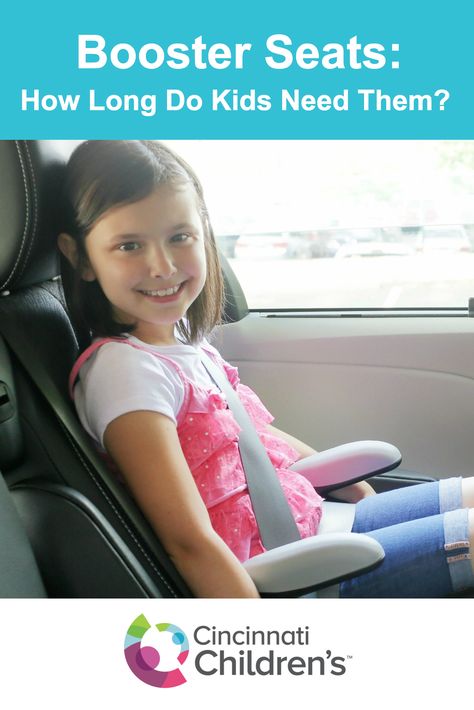 And never leave your child alone in the car, even if he is fast asleep.
And never leave your child alone in the car, even if he is fast asleep.
There are children who fall asleep as soon as they are in the car. Noise, swaying, restriction of movements soothe them, lull them to sleep. For some children, traveling in a car becomes an association with sleep. It also happens that parents specifically put their children to sleep in the car. In such cases, it is important, firstly, to observe all the listed safety rules. And secondly, try to ensure that the baby still sleeps at home in the crib too. Create car-like sleep conditions at home: swaddle or put on a sleeping bag, turn on white noise. nine0003
Some children do not sleep at all in the car, and then traveling with a child can be a real challenge. In this case, it is better to plan a trip not during sleep, but when the child is awake. Take toys with you, listen to fairy tales and songs, and the trip will be in a good mood.
Ksenia Voronezhtseva, Expert
Today they are reading
Calculate your year: what awaits you in 2023 - forecast by date of birth
Benefits for pregnant women and parents in 2023: a complete list of new payments
5 mistakes in sex education that can break the fate of a child
Online broadcast and funeral at sunset: 8 features of the burial of Elizabeth II
People against: 10 star mothers who were bullied for being thin can be dangerous for baby
Sleeping in a car seat can kill a child, pediatricians warn - almost 2/3 deaths of children in a sitting position are associated with car seats. They insist that the car seat should be used strictly for its intended purpose, and at home, the sleeping baby should be transferred to the crib. nine0003
They insist that the car seat should be used strictly for its intended purpose, and at home, the sleeping baby should be transferred to the crib. nine0003
Sleeping in a car seat can kill a child, experts from the University of Virginia and doctors from several American clinics have found out. The study was published in Pediatrics .
Pediatricians oppose baby sleep in a sitting position - every year hundreds of child deaths are associated with it. However, until now, little was known about the factors associated with child mortality in car seats and other seating devices.
The authors of the work analyzed infant mortality during sleep in 2004-2014 in the United States. They were interested in exactly where the child was at the time of death and who was nearby at that time. Of the nearly 12,000 sleep deaths, 348 occurred in devices that support children in a sitting position. nine0003
In 62% of cases these were car seats that were not used for their intended purpose.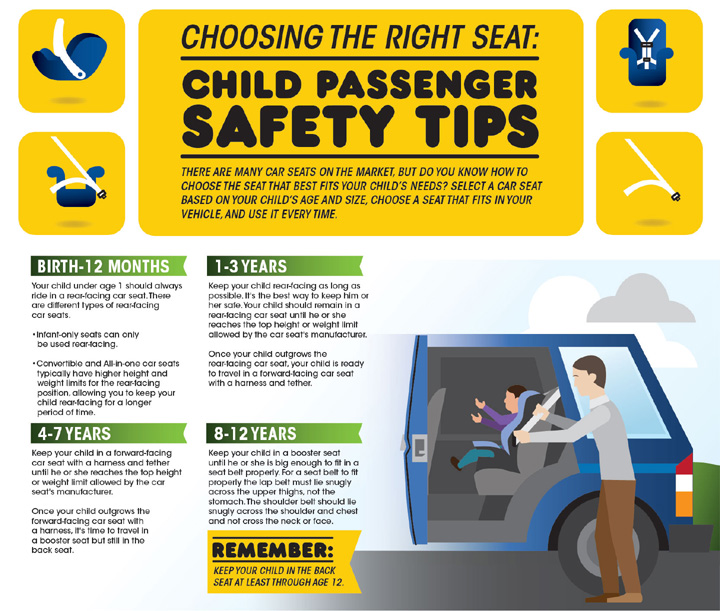
In more than half of the deaths in car seats, children died at home, more often in the presence of a guardian or nanny than parents.
"The use of car seats for other than intended purposes can be dangerous for the child," the authors of the work warn.
"Indeed, car seat-related deaths have occurred when they were used as a cot or bassinet rather than as a baby carrier," pediatrician Geoffrey Colvin, lead author of the study, confirms. - They are not as safe for sleeping as a crib or cradle. People are not very aware of this. I think every parent, myself included, has done this at least once. There are also cases where the child is left in the car seat while the parent or guardian is asleep or intoxicated.” nine0003
However, Colvin advises not to worry if the child falls asleep in the car seat during the trip.
“Children should always be in a car seat while traveling,” he stresses. - In such cases, it is absolutely safe for the baby, regardless of whether he is awake or sleeping.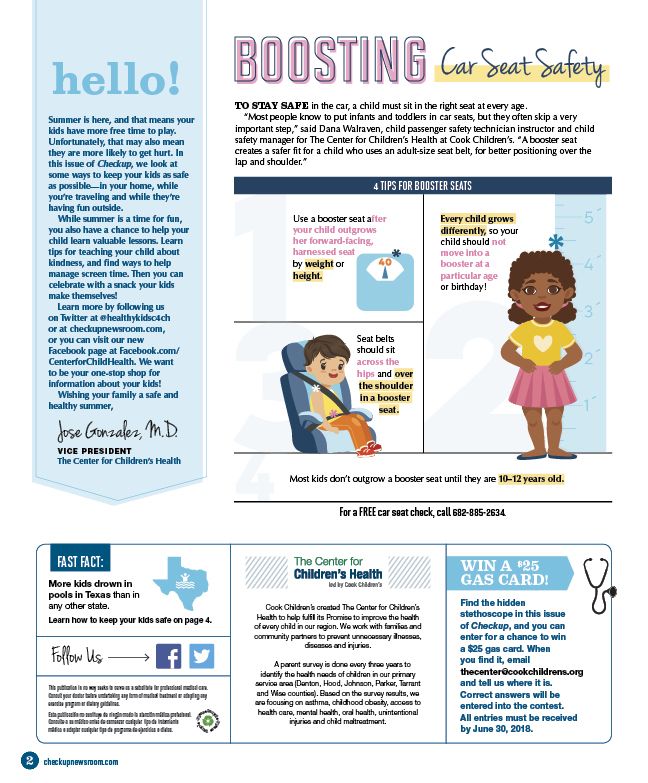 But you have to remember that car seats are for cars, and if your baby is still sleeping at the end of the trip, the best thing you can do is move him to a crib or crib.”
But you have to remember that car seats are for cars, and if your baby is still sleeping at the end of the trip, the best thing you can do is move him to a crib or crib.”
The causes of death were not considered. However, Dr. Harvey Karp explains the approximate mechanism of death of children.
Positional asphyxia is a well-known term among forensic experts. With it, suffocation occurs in a position of the body in which a person cannot breathe properly.
“When a child sleeps sitting up, his heavy head can fall forward, which will lead to difficulty breathing and even suffocation”,
says Karp, recalling the case when a one and a half year old girl died in this way, when she was left in a nursery to take a nap in an abandoned car seat parents. nine0003
Babies have weak neck muscles and soft airways, so tilting the head too far forward can be fatal, especially for a sleeping baby, the researchers explain.
In addition, the seat may fall or overturn, and the seat belts may suffocate the child.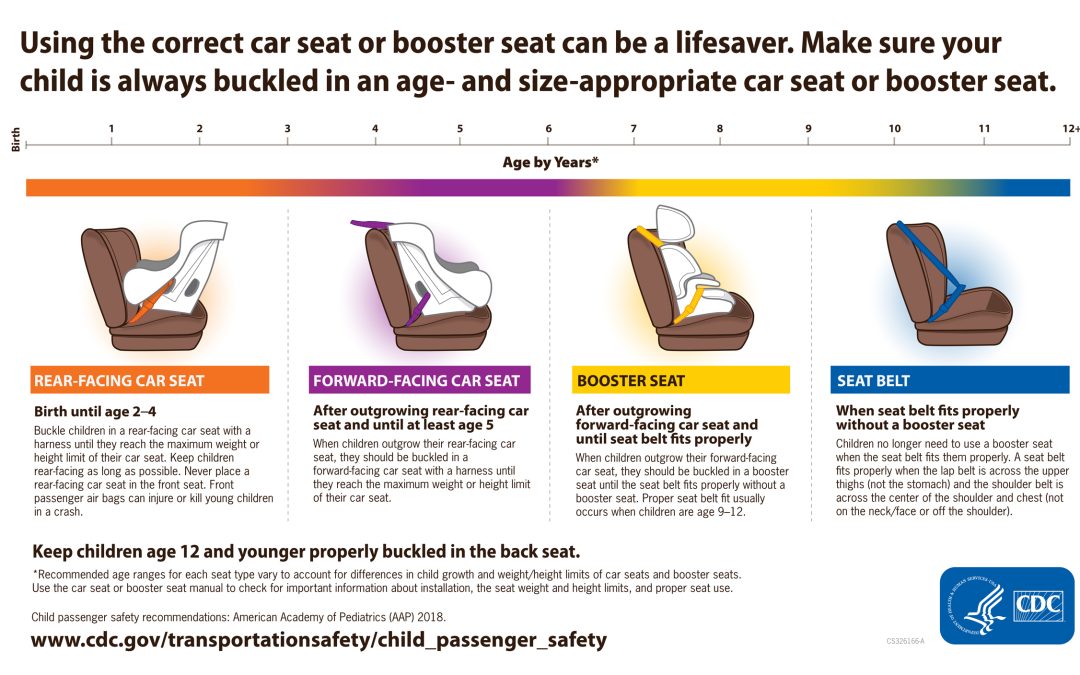
In the car, however, the seat is attached to the seat and is angled, virtually eliminating the possibility of suffocation.
Some parents can't afford to buy a crib, while others like the mobility of a car seat to keep an eye on their baby while doing other tasks. nine0003
Manufacturers of car seats, however, recommend leaving the child in them for no more than two hours, and during the trip periodically check its condition.
“If a child changes position and falls forward abruptly, parents should immediately stop and remove the child from the car seat,” recalls Cathy Holmes, a company manager.
"Car seats are important when you're traveling with your baby," says pediatrician Rachel Moon. “But don't leave your baby to sleep in them when you're at home. The safest place for a baby to sleep is on a hard, level surface." nine0003
Cribs aren't always safe for babies either - 69% of deaths in sleep are caused by bedding, found out experts from the Centers for Disease Control and Prevention.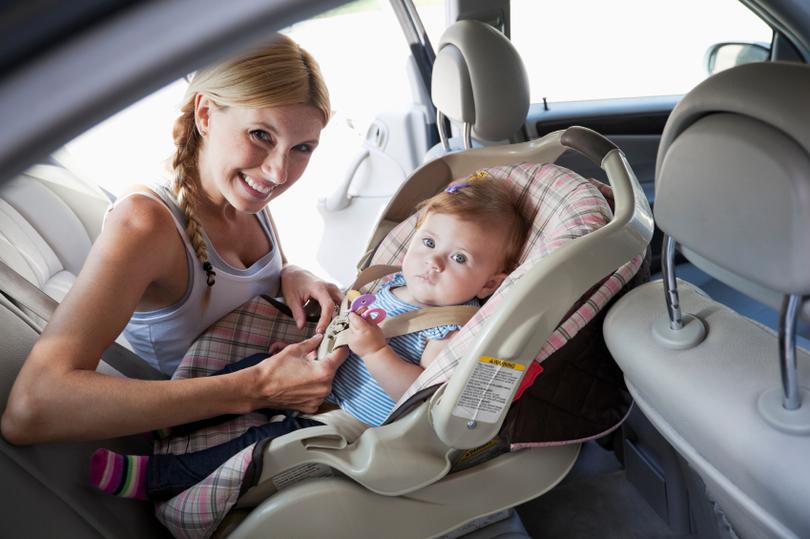
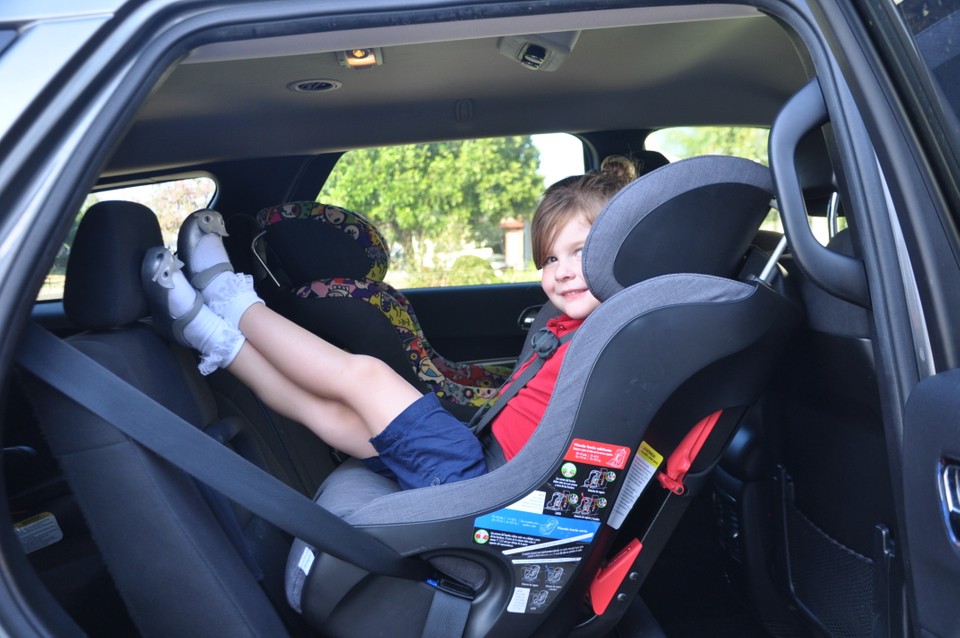 Many seats can accommodate children up to 65 pounds or more.
Many seats can accommodate children up to 65 pounds or more.